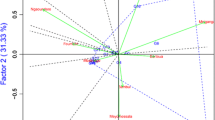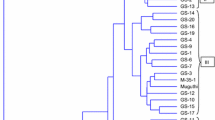Abstract
Six cassava cultivars, three yellow and three white-fleshed roots were crossed in a 3 × 3 topcross mating design to generate nine F1 populations. One thousand, one hundred and ten botanical seeds from the 9 populations were sown in pots and maintained for 42 days in a screenhouse. The emerged seedlings were transplanted to the field in April, 2010 alongside their parents (from stem cuttings), family by family. Four hundred and sixty-four progenies survived and were harvested. Both field and laboratory data were used to evaluate total carotene content (TCC), dry matter content (DMC), storage fresh root yield (SFRY) and other root quality traits. Seed germination for different populations ranged between 15.5 and 80.9 % with a mean of 43.19 %. Phenotypic variation in DMC, TCC, SFRY, biomass, root number, harvest index and cassava mosaic disease (CMD) were recorded in all the families. Average values for the populations were TCC: 4.59 μg g−1, DMC, 33.58 % and SFRY, 18.42 t ha−1. Narrow sense heritability by midparent-offspring regression analysis and genetic gains were estimated for TCC, DMC, SFRY and reaction to CMD. TCC, DMC and CMD gave high heritability estimates of 0.73, 0.83 and 0.84, respectively. SFRY, on the other hand, had a low heritability estimate (0.15). TCC was negatively correlated with DMC across all evaluation stages and locations. There were very high levels of variation in the segregating F1 progenies for all the traits. Also, narrow sense heritability estimate showed that genetic factors played a more important role than environmental factors for TCC, DMC and CMD, suggesting that reliable selection with simple recurrent phenotypic selection would be rewarding.
Similar content being viewed by others
References
Akinwale MG, Akinyele BO, Dixon AGO, Odiyi AC (2010) Genetic variability among forty-three cassava genotypes in three agroecological zones of Nigeria. Afr J Plant Sci 5(3):207–212
Baiyeri KP, Edibo GO, Obi IU, Ogbe FO, Egesi CN, Eke-Okoro ON, Okogbenin E, Dixon AGO (2008) Growth, yield and disease responses of 12 cassava genotypes evaluated for two cropping seasons in a derived savannah zone of south-eastern Nigeria. J Trop Agric Food Environ Ext 7:162–169
Bouis HE, Hotz C, McClafferty B, Meenakshi JV, Pfeiffer WH (2011) Biofortification: a new tool to reduce micronutrient malnutrition. Food Nutr Bull 32:S31–S40
Ceballos H, Hershey C, Becerra-López-Lavalle LA (2012) New approaches to cassava breeding. Plant Breed Rev 36:427–504
Ceballos H, Morante N, Sánchez T, Ortiz D, Aragón I, Chávez AL, Pizarro M, Calle F, Dufour D (2013) Rapid cycling recurrent selection for increased carotenoids content in cassava roots. Crop Sci 53:2342–2351
Chávez AL, Sánchez T, Jaramillo G, Bedoya JMI, Echeverry J, Bolaños EA, Ceballos H, Iglesias CA (2005) Variation of quality traits in cassava roots evaluated in landraces and improved clones. Euphytica 143:125–133
Esuma W, Rubaihayo P, Pariyo A, Kawuki R, Wanjala B, Nzuki I, Harvey JJW, Baguma Y (2012) Genetic diversity of provitamin A cassava in Uganda. J Plant Stud 1(1):2012
Falconer DS (1989) Introduction to quantitative genetics, 3rd edn. Longman, New York
Falconer DS, MacKay TFC (1996) Introduction to quantitative genetics. Longman, Harlow
FAOSTAT (2013) http://www.faostat.fao.org/site/368/DesktopDefault
Hallauer ARY, Miranda Filho JB (1988) Quantitative genetics in maize breeding. Iowa State University Press, Ames, pp 49–52
Hunt CA, Wholey DM, Cock JH (1977) Growth physiology of cassava. Field Crop Abstr 30:77–89
Iglesias C, Mayer J, Chavez AL, Calle F (1997) Genetic potential and stability of carotenoids content in cassava roots. Euphytica 94:367–373
Jos JS, Nair SG, Moorthy SN, Nair RB (1990) Carotene enhancement in cassava. J Root Crops 16:5–11
Kawano K (1978) Genetic improvement of cassava (Manihot esculenta Crantz) for productivity. Trop Agric Res Ser 11:9–21
Kawano K (1980) Cassava. In: Fehr WR, Hadley HH (eds) Hybridization of crop plants. American Society of Agronomy and Crop Science Society of America, Madison, pp 225–233
Kawano K, Thung M (1982) Intergenotypic competition with associated crops in cassava. Crop Sci 22:560–564
Kawano K, Narintaraporn K, Narintaraporn P, Sarakarn S, Limsila A, Limsila J, Suparhan D, Sarawat V, Watananonta W (1998) Yield improvement in a multistage breeding program for cassava. Crop Sci 38:325–332
Lynch M, Walsh B (1998) Genetics and analysis of quantitativ traits. Sinauer, Sunderland
Mahungu NM (1987) Selection for improved root quality in cassava. In: Hershey CH (ed) Cassava breeding: a multidisplinary review. Proceedings of a workshop held in the Philippines, 4–7, March, 1985. Centro International de Agricultura Tropical (CIAT), Cali, pp 89–103
Maroya NG, Kulakow P, Dixon AGO, Maziya-Dixon BB (2012) Genotype x environment interaction of Mosaic diseases, root yield and total carotene concentration of yellow-fleshed cassava in Nigeria. Int J Agron, p 8
Ogbe FO, Thottappilly G, Dixon AGO, Atiri GI, Mignouna HD (2003) Variants of East African cassava mosaic virus and its distribution in double infections with African cassava mosaic virus in Nigeria. Plant Dis 87:229–232
Payne RW, Harding SA, Murray DA, Soutar DM, Baird DB, Glaser AI, Channing IC, Welham SJ, Gilmour AR, Thompson R, Webster R (2009) The guide to GenStat release 12, Part 2: statistics. VSN International, Hemel Hempstead
Rickard JE, Behn KR (1987) Evaluation of acid and enzyme hydrolytic methods for the determination of cassava starch. J Sci Food Agric 41:373–379
Rodriguez-Amaya DB, Kimura M (2004) HarvestPlus handbook for carotenoid analysis. HarvestPlus Technical Monograph 2. Washington, DC and Cali. International Food Policy Research Institute (IFPRI) and International Center for Tropical Agriculture (CIAT)
Sánchez T, Ceballos H, Dufour D, Ortiz D, Morante N, Calle F, Zum Felde T, Davrieux F (2014) Carotenoids and dry matter Prediction by NIRS and hunter color in fresh cassava roots. Food Chem 151:444–451
Vimala B, Nambisan B, Theshara R, Unnikrishnam M (2008) Variability of carotenoids in yellow-flesh cassava (Manihot esculatar Crantz).Geneconserve. Pro. br., p 1
Acknowledgments
This study was carried out with the financial support of the West Africa Centre for Crop Improvement (WACCI), University of Ghana, Legon, and the National Root Crops Research Institute (NRCRI), Umudike, Nigeria, to the first author. We are also grateful to AGRA for the grant to WACCI.
Author information
Authors and Affiliations
Corresponding author
Rights and permissions
About this article
Cite this article
Njoku, D.N., Gracen, V.E., Offei, S.K. et al. Parent-offspring regression analysis for total carotenoids and some agronomic traits in cassava. Euphytica 206, 657–666 (2015). https://doi.org/10.1007/s10681-015-1482-4
Received:
Accepted:
Published:
Issue Date:
DOI: https://doi.org/10.1007/s10681-015-1482-4




